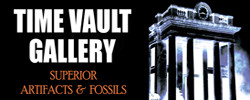Product Description
SEE MORE CHALCOLITHIC COPPER AGE ARTIFACTS
This RARE, genuine Chalcolithic metalsmithing ground stone creasing hammer was found in Hungary. It comes from the Baden Culture - a European Middle Chalcolithic (Copper Age) Culture. The Baden Culture, or Baden-Pécel Culture, is a Chalcolithic archaeological culture dating to 3520–2690 BC. It is found in Central and Southeast Europe, and is known from Czech Republic, Romania, Hungary, southern Poland, Slovakia, northern Croatia and eastern Austria.
Used to hammer-form metal sheet such as copper, silver and gold, this small ground stone hammer has a ridged axe shape end. It is a creasing hammer, used in metalforming to put sharp bends and creases in the work. Hammers like this were used in repoussé and chasing techniques. Repoussé is a metalworking technique in which a malleable metal is shaped by hammering from the reverse side to create a design in low relief. Chasing or embossing, is a similar technique in which the piece is hammered on the front side, sinking the metal. The two techniques are often used in conjunction.
For the first time, we offer this rare metalsmithing stone hammer. It shows use wear on the end, and is complete. The indented other end is shaped that way to allow the hammer to be hafted onto a small wooden handle. Ancient metalsmithing tools like this are exceptionally rare!
HISTORY
The Chalcolithic (also called the Copper Age and Eneolithic) is an archaeological period characterized by the increasing use of smelted copper. It follows the Neolithic and precedes the Bronze Age. It occurs at different periods in different areas of the world, and is absent in some parts of the world, such as Russia. Stone tools were still predominantly used during this period.
Before the Baden culture, there was no culture that was centralized in the Carpathian Basin and completely filled it, but the Baden-Pécel culture transcends the Carpathian Basin, which proves that it was a populous and unified culture. It can be observed that in the center of some settlements, a larger building was constructed, and crown-like decorations were also found in some cemeteries, perhaps indicating that a kind of patronage society was characteristic of the culture.
Examining the artifacts, archaeologists have concluded that although the settlements were large, they were seasonal "towns", and their inhabitants were constantly changing. This would explain why we find such a high number of settlements linked to the culture. However, the archaeological evidence shows that there were also settlements that were fortified and served as a kind of center, and were permanently inhabited. These settlements were mainly found on hilltops.
The economy was mixed. Full-scale agriculture was present, along with the keeping of domestic stock—pigs, goats, etc. The Baden culture has some of the earliest attestation of often wheeled, wagon-shaped models in pottery, sometimes with a handle. There are burials of pairs of cattle that have been interpreted as draft animals. Though there are no finds of actual wagons, some scholars take these finds together as proof for the presence of real wagons.
 US DOLLAR
US DOLLAR
 EURO
EURO
 AUSTRALIAN DOLLAR
AUSTRALIAN DOLLAR
 CANADIAN DOLLAR
CANADIAN DOLLAR
 POUND STERLING
POUND STERLING


















